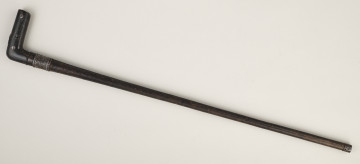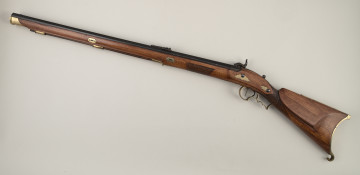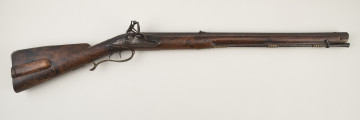
Shooting stick
20th century
Castle Museum in Łańcut
Part of the collection: Broń, instrumenty, varia
The invention of gunpowder on battlefields resulted in another “arms race.” Work on new types of long arms and handguns was started; calibres were changed in search for the most proper to penetrate through the armour, their weight and dimensions were adjusted to offer the possibility of shooting while riding a horse. To improve accuracy, more and more precise sights started to be applied. An important element allowing for shooting efficiently irrespective of the weather conditions and individual training was the reliable lock. The first match-locks were very sensitive to humidity. Wheel-locks, more efficient and less susceptible to weather conditions were expensive, complex and they required professional servicing. A breakthrough happened with the introduction of the flint-lock mechanism, which allowed for fuller use of the firearms by infantry and cavalry units. The idea of operation of such locks consists in placement of a piece of flint between a set of jaws. After pulling the trigger, the flint strikes a piece of steel creating a spark, which ignites the powder. Flame burns through a small touch hole into the gun barrel and ignites the main propellant charge, causing the weapon to fire off the projectile. A wall gun in the collection of our museum is equipped with this type of a flint-lock mechanism. It was produced at the beginning of the 19th century in Legnica (Liegnitz) by a company called Malina. The barrel is 878 mm and is smoothbore. The handguard is made of brown nut wood. Traces after two missing casings for the pull-through, used to place the ramrod, are visible; the gun has a slightly marked cheek pad. The visitors may find it interesting that it is a 29 mm calibre gun, which ˗ as compared to the present-day calibres ˗ almost makes it a “cannon.” The entire gun, both its metal and wooden elements, bears traces of decoration. The condition of the gun, the absence of the trigger, the trigger guard and the casings for the pull-through, as well as damages in wood and traces of rust may indicate that it was kept in soil or in water for an extended period of time.
Author / creator
Dimensions
height: 127 cm, width: 35 cm
Object type
Weapons, instruments, varia
Technique
metallurgical
Material
wood, steel
Creation time / dating
Creation / finding place
Owner
Castle Museum in Łańcut
Identification number
Location / status

20th century
Castle Museum in Łańcut

18th century
Castle Museum in Łańcut

18th century
Castle Museum in Łańcut
DISCOVER this TOPIC
Museum of King Jan III's Palace at Wilanów
DISCOVER this PATH
Educational path